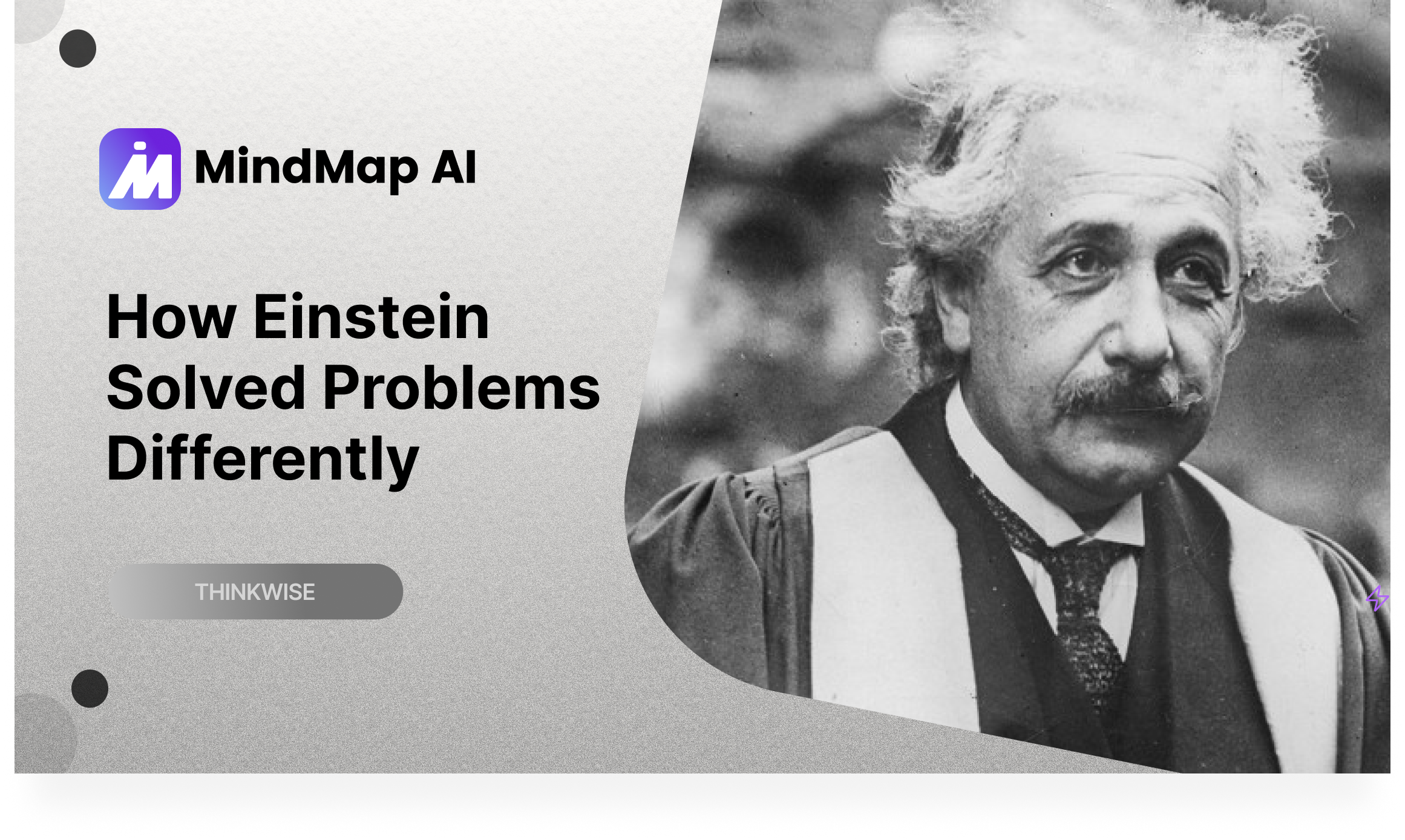
Einstein's Secret to Solving Any Problem
Look, we've all been there. A problem pops up and we immediately start throwing solutions at it. But here's something wild: Einstein supposedly said if he had an hour to save the world, he'd spend 55 minutes just figuring out what the problem actually was.
Seems backwards, right? Turns out, it's genius.
Why We Suck at Defining Problems (And Why It Matters)
Most of us treat problem definition like the annoying warmup before the real workout. We want to get to solutions now. But here's what nobody tells you: crap problem definition = crap solutions. Every single time.
Think of it this way. If you're trying to navigate somewhere but your starting point on the map is wrong, it doesn't matter how good your directions are. You're already lost.
The good news? Getting better at defining problems is a learnable skill. Here are ten ways to do it that actually work.
Want to organize your thoughts like Einstein did?
1. Change the Words, Change Everything
There's this story about a Toyota executive that perfectly illustrates this. He asked employees to brainstorm "ways to increase productivity." Cricket sounds. Nothing. Then he switched it up: "ways to make your jobs easier." Boom. Suggestions everywhere.
Same problem. Different words. Totally different results.
Try this: Take your problem and rewrite it five different ways. Swap out the main verbs. "Increase sales" could become "attract customers," "retain buyers," "encourage repeat purchases." Each version opens up different solution paths your brain wouldn't have explored otherwise.
2. Your Assumptions Are Probably Wrong
Every problem comes loaded with assumptions we don't even realize we're making. And a lot of them are just wrong.
Here's a simple exercise: Write down every assumption you can think of about your problem. Especially the "obvious" ones that seem untouchable. Then attack each one. "Does this HAVE to be true? What if it wasn't?"
Example: Opening a restaurant? You probably assume "restaurants need menus." But what if they didn't? Maybe customers text you ingredients they have at home and you create dishes on the spot. Or they vote on daily specials through an app. Suddenly you're in completely new territory.
3. Zoom Out When You're Lost in the Weeds
Sometimes you're so deep in details that you can't see what you're actually trying to accomplish. When that happens, step back and ask bigger questions.
"What's this really about?" "What's the actual goal here?" "What am I ultimately trying to achieve?"
If you're stuck on "how to get more email subscribers," zoom out to "how do I build a community of people who trust me?" Different problems. Different solutions. Probably better ones.
Want to see how all your challenges connect?
4. Break It Down When It Feels Overwhelming
Big scary problems paralyze us. But here's a secret: every huge problem is just a bunch of smaller problems wearing a trench coat.
Take that massive overwhelming thing and break it into pieces. What are the specific parts? What are concrete examples of this issue showing up?
"Improve customer experience" is terrifying. "Reduce checkout time by 30 seconds" or "respond to support tickets within 2 hours" are things you can actually tackle.
5. Look at It Through Someone Else's Eyes
Your perspective is limited. Sorry, but it's true. Mine is too. Everyone is.
So force yourself to see your problem from different angles. How would your customer view this? Your competitor? Your employee? Your grandmother?
Each perspective reveals something you missed. If you're trying to "increase sales," your customer might be thinking "I wish this product had X feature I'd actually pay for." That's a completely different direction than "run more ads."
6. The Way You Word It Changes How Your Brain Works
Some problem statements make your brain shut down. Others get it fired up. The difference is usually in how you phrase things.
Instead of "How can I" try "In what ways might I" It's subtle but powerful. The first suggests maybe there's one answer (or none). The second assumes multiple solutions exist and invites your brain to find them.
Also, flip negative problems into positive goals. "Stop wasting time" becomes "use time effectively" or better yet, "accomplish what matters most." Your brain likes moving toward good things more than running from bad ones.
Try this formula: "In what ways might I [do something] to [accomplish this result]?"
Example: "In what ways might I redesign my website to get visitors to actually read my content?"
7. Make It Something You Actually Care About
If your problem statement bores you, you're not going to put real energy into solving it. It's that simple.
"Increase revenue" is a corporate-speak snooze-fest. "Build something people can't stop talking about" is something that might get you out of bed at 6am with ideas.
Keep the problem genuine, but find the version that makes you excited to work on it. Your brain's creative engine runs on enthusiasm.
8. Flip It Upside Down
Stuck? Try the opposite. Want to increase sales? List every way you could possibly DECREASE sales. Then flip those answers around.
"Stop returning customer calls" becomes "Always return calls promptly." "Make the website confusing" becomes "Simplify navigation." Sometimes the solutions are obvious, but we only see them when we come at the problem backwards.
Weird trick, but it works.
9. Get the Facts Before You Start Guessing
If your problem is vague, don't try to solve it yet. Investigate it first. What's actually happening? When did it start? What are the specific circumstances?
"You never listen to me" is impossible to solve. "You check your phone when I'm talking about my day" is very solvable.
The more specific your problem definition, the more obvious the solution becomes. Sometimes a perfectly-defined problem isn't even a problem anymore, it's just an action item.
10. Use Creative Techniques on the Problem Itself
Meta, I know. But defining the problem IS a creative challenge. So use brainstorming techniques on it.
Give yourself a quota: write 20 different versions of your problem statement. Make a list of 100 related issues. Use any creative thinking tool you know, but apply it to understanding the problem, not solving it.
The Balance Nobody Talks About
Okay, real talk: You probably don't need to spend 55 out of 60 minutes on problem definition. Einstein was making a point, not giving you a recipe.
But most of us are doing the opposite spending 1 minute understanding and 59 minutes flailing around with solutions that don't work.
When you start really paying attention to problem definition, you'll notice something interesting: it's often harder than finding solutions. But the payoff is massive. Better problems lead to easier, more effective solutions. Problems you feel confident tackling. Problems actually worth solving.
Want to track your problem-solving progress over time?
Start Here
Next time you face a challenge big or small try this:
Before you think about solutions at all, spend 10 minutes with your problem statement. Pick two or three techniques from this list. Rephrase it. Challenge your assumptions. Look at it from a different angle.
You'll be shocked how often the "right" solution becomes completely obvious once you're looking at the right problem.
That's Einstein's real secret. Not being smarter than everyone else (though that probably helped). But being willing to make sure he was solving the right thing before he started solving anything at all.
FAQ
Q1: Did Einstein really say he’d spend 55 minutes defining a problem?
A: The quote can’t be verified, but it perfectly captures Einstein’s mindset. He believed that understanding a problem deeply was far more valuable than jumping straight into solutions. The more clarity you have, the less effort you waste.
Q2: Why is problem definition so important in problem-solving?
A: Because if you define the wrong problem, even great solutions won’t help. Clear problem definition helps you target the real issue instead of symptoms, saving time, resources, and frustration.
Q3: How can I apply Einstein’s problem-solving approach in my business or career?
A: Before making decisions or launching new projects, spend time reframing the challenge. Identify what’s really blocking progress, gather facts, and look at the issue through your customer’s or competitor’s eyes. This leads to smarter strategies and fewer false starts.
Q4: How much time should I spend defining a problem?
A: You don’t need 55 minutes of every hour, but most people underinvest. Spending even 10–15 minutes clarifying what’s really wrong can make execution 5× faster and far more effective.








